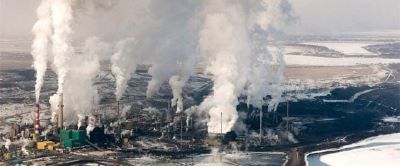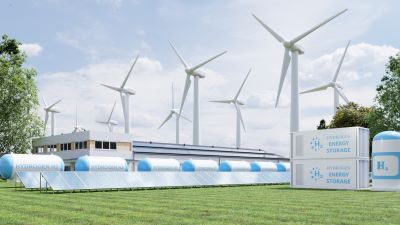Alberta’s oilsands: cash-generating machines or increasing liability in energy transition?
 Alberta’s oilsands production plants have become “lucrative cash-generating machines” that underpin Alberta’s and the national economies and Canada’s exports.
Alberta’s oilsands production plants have become “lucrative cash-generating machines” that underpin Alberta’s and the national economies and Canada’s exports.
But the oilsands industry – especially over the next two to three decades – faces numerous challenges that could spell its demise, either gradually or much faster than anyone expected.
That was the consensus among economic, energy and policy experts at a March 13 webinar presented by the Energy vs Climate webinar/podcast series focused on tradeoffs in the energy transition to net zero.
 “These [oilsands production] facilities in some cases are making $40 to $50 a barrel pre-tax operating profit now,” even with operating costs and paying government royalties, said energy and environmental economist Andrew Leach (photo at left), a professor of economics and law at the University of Alberta. “They’re lucrative cash-generating machines, at this point.”
“These [oilsands production] facilities in some cases are making $40 to $50 a barrel pre-tax operating profit now,” even with operating costs and paying government royalties, said energy and environmental economist Andrew Leach (photo at left), a professor of economics and law at the University of Alberta. “They’re lucrative cash-generating machines, at this point.”
However, given uncertainties in the world oil market, the pressures of climate change and the energy transition to net zero, and plentiful oil that’s cheaper to produce, the oilsands also could be seen as “a marginal, barely profitable industry that could go away tomorrow,” he said.
 On the other hand, policymakers could decide that climate is going to suffer and that they’re going to let the oilsands plants continue operating as usual to capture as much wealth as possible, until such time that world oil prices or other pressures force their closure, said panel moderator Ed Whittingham (photo at left), a clean energy/policy finance professional and Public Policy Forum fellow at the Pembina Institute.
On the other hand, policymakers could decide that climate is going to suffer and that they’re going to let the oilsands plants continue operating as usual to capture as much wealth as possible, until such time that world oil prices or other pressures force their closure, said panel moderator Ed Whittingham (photo at left), a clean energy/policy finance professional and Public Policy Forum fellow at the Pembina Institute.
 But Sara Hastings-Simon (photo at right), a professor in the University of Calgary’s Faculty of Science whose research focuses on the energy transition, argued: “We can’t decide let’s not close down the oilsands and let’s just keep them running at this level of productivity for the next 40 years.”
But Sara Hastings-Simon (photo at right), a professor in the University of Calgary’s Faculty of Science whose research focuses on the energy transition, argued: “We can’t decide let’s not close down the oilsands and let’s just keep them running at this level of productivity for the next 40 years.”
At the same time, contemplating the end of the industry should compel governments to carefully prepare for that scenario, she said. “Governments can do things like making investments in infrastructure-writ-large, improving education and all these pieces that really create the ingredients that are necessary to have productivity growth within an economy,” Hastings-Simon said.
.png) “Alberta is really a very unusually oil-dependent place,” said David Keith (photo at left), professor and founding faculty director of the Climate Systems Engineering Initiative at the University of Chicago. There’s no question that making the global transition away from oil is “going to be really painful,” he said.
“Alberta is really a very unusually oil-dependent place,” said David Keith (photo at left), professor and founding faculty director of the Climate Systems Engineering Initiative at the University of Chicago. There’s no question that making the global transition away from oil is “going to be really painful,” he said.
“I think the thing I’m most worried about – I’m even panicked about – is the sense that people in the Alberta and Canadian governments just are blind to that reality,” said Keith, who travels between Chicago and his home in Canmore, Alberta. “They’re just not thinking seriously about the challenge they face. And you can’t govern well if you’re blinding yourself to reality.”
Oilsands provide massive economic benefits
The oilsands now constitute “the lion’s share” of Canadian oil production in terms of GDP, resource revenues and exports, Leach said. Their contribution amounts to about 10 per cent of Canada’s GDP.
Canada’s oil and gas industry directly employs some 300,000 workers, with an estimated 400,000 to 600,000 indirect and induced jobs on top of that, Leach said. One-third of Canada’s exports are energy products, 30 per cent of it oil and natural gas.
Alberta’s most recent budget included current revenues of about $13 billion from oilsands royalties – more than one-quarter of the province’s budget – plus another $5 billion a year in the near future, he noted.
The federal government reaps revenues from corporate taxes on oil and gas companies, workers’ personal income taxes, and exports, Leach said. “It’s a massive sector and has a massive impact on our economy, no matter how you qualify it.”
Oilsands production continues to grow, although it is far short of the levels initially forecast. Production hit an all-time record of 4.2 million barrels per day (b/d) in November 2023, and an average 3.9 million b/d in the first 11 months of last year. However, less than two decades ago, the industry and the Alberta government had forecast production hitting 6 to 7 million b/d by now.
“The number now is half of what we thought it might be back in the early 2010s that looked at growth trends and numbers of applications announced by companies,” Whittingham said.
Construction of new oilsands facilities also has significantly slowed compared with 20 years ago when several new in situ steam-assisted gravity drainage projects (which inject steam into reservoirs to extract oilsands bitumen) were built.
Skyrocketing project costs of labour and in supply chains curbed that growth and made many planned projects economically unfeasible, Leach said. Other factors included uncertainty about whether new pipelines could be built to transport oilsands production and growing pressures to reduce greenhouse gas emissions.
Now the pressures on the oilsands industry are centred on financing and insurance and the continuing uncertainty over global oil markets, Leach said.
“It’s not just oilsands. You look globally across the oil sector [at] that willingness to invest in a project that has its first oil three to seven years from now, and then is going to produce for another 30 years beyond that, you’re making a really big bet on the long-term oil market.”
The world also has ample oil supplies that are much cheaper to produce and refine than the heavy crude from Alberta’s oilsands, such as light oil in Saudi Arabia. Also, light oil produced in the U.S. from hydraulic fracturing of geologically “tight” reservoirs is a cheaper alternative, and has driven much of the investment and production growth in North America, Leach noted.
Current investment by world oil companies has declined and is not matching the industry’s rhetoric – or the Alberta government’s – about continuing demand for oil and the need to keep increasing production, he said. “The oil companies are not putting their money where their forecasts are.”
Nevertheless, global oil industry investment is still higher than what would be expected under the International Energy Agency (IEA) scenarios for declining oil demand in shifting to a net-zero emissions world or near net-zero, he added.
The IEA now predicts a plateau in demand for all fossil fuels by 2030. In its report on the role of the oil and gas industry as the world shifts to net-zero emissions, the IEA noted that “many producers say they will be the ones to keep producing throughout transitions and beyond. They cannot all be right.”
Leach said depending how aggressive global climate policies get, there are two possible scenarios that could dramatically affect the fate of Alberta’s oilsands.
A relatively unlikely scenario, he said, is a higher world oil price coupled with declining demand and declining production. The other scenario is “a world where everybody keeps betting on: ‘We’re going to keep using oil and we’re going to have the last barrel standing.’” This latter scenario could result in a world over-supplied with oil, resulting in a price collapse – as was seen in 2015-2016.
Is the oilsands industry really serious about reducing total emissions?
In Alberta, a new major oilsands project hasn’t been announced in six years. Several foreign companies have exited the industry, including Royal Dutch Shell, Chevron, Devon Energy Corp., BP and Statoil, and remaining players have bought other companies’ operations.
Some of the remaining companies are investing in expansions of existing facilities, but in only incremental levels of production – around 25,000 to 30,000 barrels per day, Leach said. “There is still capital flowing in. It’s nowhere near what it was in 2014, and most of it is just flowing to the existing projects and expanding production in those existing projects.”
Another pressure on the oilsands that’s unlikely to ease is the need to reduce greenhouse gas (GHG) emissions. Canada’s oil and gas production accounts for 189 million tonnes of GHGs according to the last available emissions inventory, or 28 per cent of Canada’s total emissions.
“Alberta has 260 Mt or so out of that national total, well better than a third of the national emissions, and a lot of that is coming from those large industrial facilities – the oilsands, the refining, the petrochemicals – that all runs from that oil and gas economy,” Leach said.
The oilsands has reduced its “emissions intensity” (the amount of emissions per barrel of oil produced) by 23 per cent since 2009, as of 2022. However, total emissions have increased along with total production, and the emissions intensity reduction has levelled off.
As the large legacy in situ projects get older, with their wells cycling down at the end of their life, these facilities’ emissions intensity dramatically increases, Leach said.
“You listen to headlines, it sounds like ‘Wow, they’ve really driven this [emissions intensity] down over the last couple of years.’ But there hasn’t been a big level shift as those ones we had earlier on in the history of the industry,” he said.
There is also a big question about whether Alberta’s oilsands industry is really serious about reducing total, or absolute, GHG emissions, Hastings-Simon said.
The industry has complained that the federal government’s proposed cap on oil and gas emissions amounts to a cap on production, and that the oilsands can’t continue to produce at current levels with such a cap.
But Hastings-Simon pointed out that the 20 million tonnes (Mt) of emissions reduction required by the federal cap by 2030 is actually less than the 22 Mt-reduction that the Pathways Alliance, a group of the largest oilsands producers, has said it will achieve with its proposed $16.5-billion carbon capture and storge network.
“As recently as early 2023, they [the oilsands industry and provincial politicians] said this was an ambitious but achievable cap. They talked about it a lot at COP28 (the UN’s climate summit) as a big part of the solution,” she said. “And yet back here in Canada they say, ‘We can’t do this.’”
The federal cap on oil and gas industry emissions will essentially be a test on whether the oilsands industry is really serious and actually intends to build its CCS network, Hastings-Simon said. “Are you really ready to put your money where your mouth is that this is what you’re going to do? Or is this just a PR stunt?”
The federal government has offered a tax credit for carbon capture, storage and utilization, at 50 per cent for investments in carbon dioxide capture equipment, and 37.5 per cent for equipment used for transportation and storage. The Alberta government has a new 12-per-cent grant on capital expenditures for CCS initiatives.
But Rhona DelFrari, chief sustainability officer for Cenovus Energy, a member of Pathways Alliance, said earlier this month that government-funding partnerships aren’t yet enough for large-scale CCS in the oilsands. Pathways also wants more clarity about Ottawa’s pledge to provide “contracts for difference,” which would essentially guarantee the industry a future carbon price.
When it comes to the conventional oil and gas sector and its outstanding liabilities (about $130 billion as of 2020) for cleaning up old wells and related infrastructure, “there’s a lot of promises being made about plans, and then not coming through,” Hastings-Simon said.
The oilsands have facility-closure, reclamation and other liabilities that, conservatively, amount to at least $35 billion, she noted. Yet the actual amount the industry has committed in liability security deposits is only $1 billion. “There’s a bit of borrowing from the future as to who’s actually going to be around to clean that [oilsands industry] up.”
Market demand and new technology deployment can change rapidly
Keith said he doesn’t see any “sensible prospect” of using carbon capture and storage in the oilsands. The oilsands are too far away from good geological reservoirs in which to permanently sequester, or store, the captured carbon dioxide, he said.
Also, “it’s not clear it makes sense to scrub the CO2 from that basically declining resource,” he added. “Because in a world where we’re really acting fast on climate, what we are doing about the oilsands is gradually closing them down.”
It would make sense to use CCS to reduce GHG emissions from cement- and steel-making plants because we’ll still need those products, he said. “There are places where CCS has a sensible role in a rapidly decarbonizing economy. But I don’t think oilsands is it.”
Hastings-Simon said governments providing generous subsidies to support CCS in the oilsands also raises questions about the wisdom of making significant public investments to decarbonize the oilsands, versus investing that money in other things that could make Canada’s economy more productive.
For example, Canada, with its ongoing decline in productivity, looks longingly at productivity levels in the U.S., she said. “But we’re not doing the same thing. We’re not investing in innovation in the same open way that the U.S. is, versus having it more tied to the industries that we have today.”
In the short term, it’s likely that many existing oilsands projects will continue to produce, albeit at somewhat lower oil prices, less revenue and lower profits, Hastings-Simon said.
Beyond the short term, however, the oft-heard industry argument that refineries will continue to need Alberta’s oilsands heavy crude because that’s what these refineries were designed for overlooks the impact of transition to lower-carbon fuels, she said. “So once you get into that transition phase . . . and if we’re actually going to be using much less oil in the world, then we’re going to have to have some major changes to our set of refineries.”
“I think that is the moment when the Canadian oilsands starts to become really challenged,” Hastings-Simon said. Canada will no longer be competing against only heavy crude from other countries, but against cheaper-to-produce, lower-carbon and more easily refined oil from places like Saudi Arabia or shale oil from the U.S.
It’s also important not to underestimate how fast markets can shift and how rapidly new technologies can penetrate the global market, the panelists said.
Many people underestimated how fast sales of battery-electric vehicles would grow, Keith said. Also, he added, it does feel like the world is going to move in a serious way to restrict carbon emissions. “I’m really quite confident about that.”
Closing the oilsands will be economically and socially painful
Whether it is a policy decision to gradually wind down the oilsands, or whether the industry is forced to shutter because of world oil prices and other pressures, all the panelists agreed the closure will be economically and socially painful.
One member of the webinar audience pointed out that producing non-conventional oil has a productivity level of $1,000 per hour compared with roughly $60 per hour for all other industries. “When we’re gradually closing down the oilsands, we’re gradually closing down the highest-value dollar creator in Canada,” he commented.
Leach agreed that, “You can’t just compare somebody producing another good or service from scratch versus somebody extracting oil, and fail to value the oil in that equation.”
When the Newfoundland cod fishery was forced to close due to declining cod numbers, it was a regional calamity that had some national spillover, he said. But this fishery was heavily subsidized, including labour and workers that earned far below the provincial and national average for wages.
In comparison, oil and gas workers are currently making two to three times the national average for wages. Plus it’s a sector that produces massive revenue for government as well as its workforce.
“So gradually closing down the oilsands is a very different decision than we’ve made about [having to close] coal power, Newfoundland cod, asbestos – that we’ve made about any of these other things, and it’s on a much larger scale,” Leach said.
Closing the oilsands will affect “real people in Alberta,” he said. “These are not just abstract numbers on a spreadsheet. This is a person to whom I’m saying, ‘Nice job you had there, but sorry.’’’
It’s easier to shutter an industry that is non-viable and there’s an easy alternative, with a better job down the road with higher pay, Leach said. “It’s much, much harder to do when the global market is saying please give me this stuff and we’re willing to pay a lot for it, and you’re trying to tell someone to take a worse job so we can avoid meeting that global demand.”
R$
Events For Leaders in
Science, Tech, Innovation, and Policy
Discuss and learn from those in the know at our virtual and in-person events.
See Upcoming Events
You have 0 free articles remaining.
Don't miss out - start your free trial today.
Start your FREE trial Already a member? Log in
By using this website, you agree to our use of cookies. We use cookies to provide you with a great experience and to help our website run effectively in accordance with our Privacy Policy and Terms of Service.




